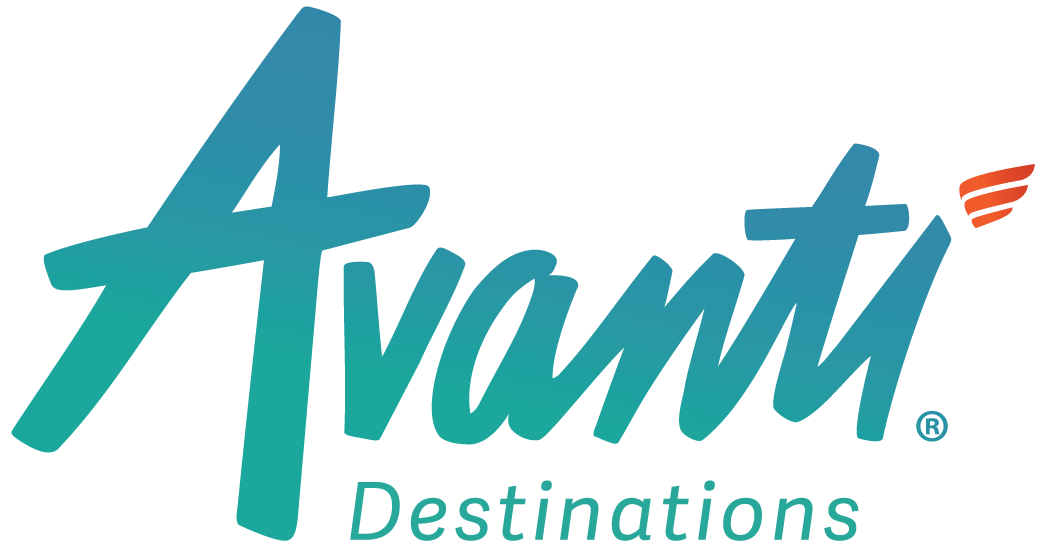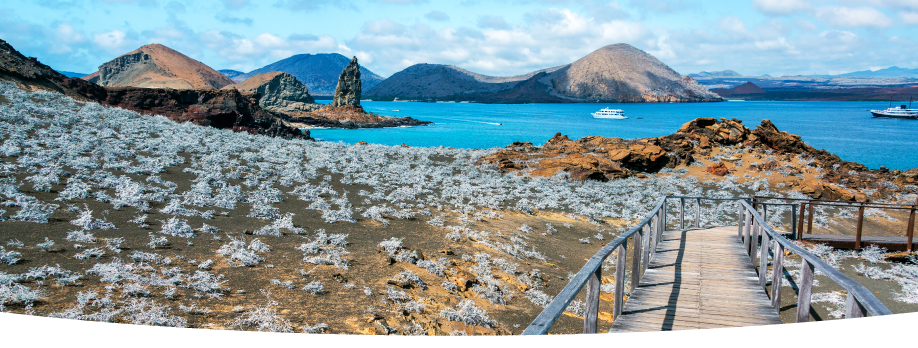

Luxury Yacht Ocean Spray
14 Night Cruise
14 Night Cruise
The Ultimate Galapagos Experience! The new Mega-Catamaran Ocean Spray offers the best performance and comfort in Galapagos Cruising. The elegant design includes a huge sundeck, jacuzzi and spacious cabins each with a private balcony.
INCLUSIONS
• Roundtrip air & ground transfers
• Cruise accommodations
• Cruise accommodations
• Galapagos National Park Entrance Fee
• Excursions with naturalist guide
• Excursions with naturalist guide
• All Meals
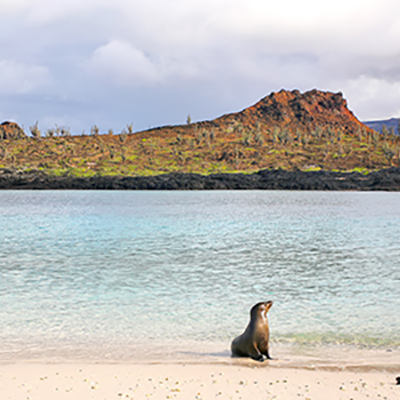
Saturday: Flight to Galapagos from Quito/Guayaquil Airport - Sombrero Chino Island:
AM: Arrival: Upon arrival at Baltra Island, guides will meet you, collect your luggage, and escort you to the harbor for a short ferry ride to the ship, where the crew will welcome you aboard. After a welcome cocktail and an orientation and safety briefing the cruise begins.
PM: Sombrero Chino Island: We have a wet landing on a beautiful crescent-shaped beach, home to sea lions and Sally Lightfoot crabs. Sombrero Chino means "Chinese hat" and the island gets its name due to its shape. Look for marine iguanas as you explore. The water is calm here and makes for excellent snorkeling.
(Lunch, Dinner & Accommodations, Ocean Spray)
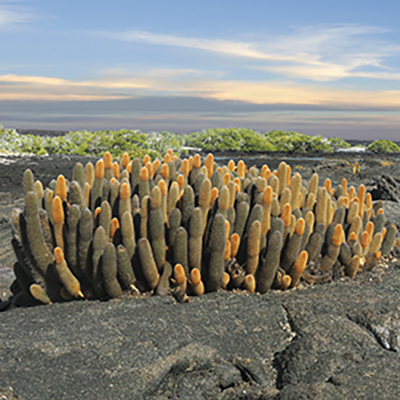
Sunday: Isabela Island - Fernandina Island:
AM: Isabela - Vicente Roca Point: The largest in the archipelago, this seahorse-shaped island is also one of the youngest and most volcanically active. This morning, visit to Vicente Roca Point. Comprised of two separate coves, this site is a large bay with spectacular sea life. Keep an eye out for seahorses, sea turtles, and the strange yet fascinating Mola-mola (sunfish).
PM: Fernandina - Espinosa Point: Crossing the Bolivar Channel that divides Isabela and Fernandina Islands, we will land at Espinosa Point. After walking past a colony of marine iguanas and a group of sea lions, we'll reach the island's highlight: the flightless cormorant nesting site. This area also provides a great opportunity to see the Galapagos hawk.
(Breakfast, Lunch, Dinner & Accommodations, Ocean Spray)
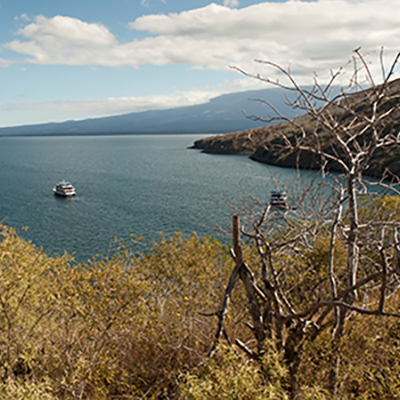
Monday: Isabela Island:
AM: Tagus Cove: Tagus Cove is located across from Fernandina Island, near the Bolivar Channel dividing the two islands. Ships have frequented this spot since the 1800s, using the area as an anchorage site. Trails wind by Lake Darwin up to a ridge and display wonderful views. Punta Tortuga, just north of Tagus Cove, is another lovely beach surrounded by mangroves.
PM: Urbina Bay: Urbina Bay is located at the base of Alcedo Volcano on the west coast, between Tagus Cove and Elizabeth Bay. This area experienced a major uplift in 1954, causing the land to rise over 16 feet. The coast expanded half a mile out, leaving marine life stranded on the new shore. The largest iguanas in the islands live here. This area is also a great place for snorkeling.
(Breakfast, Lunch, Dinner & Accommodations, Ocean Spray)
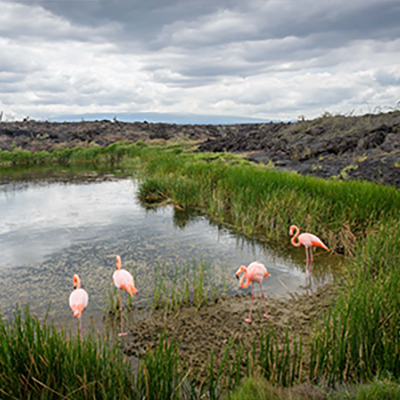
Tuesday: Isabela Island:
AM: Elizabeth Bay: Elizabeth Bay is located on the east coast of Isabela Island. The bay contains many islets, which can be visited by dinghy. Penguins and blue-footed boobies can be spotted on the rocky islets. With an abundance of marine life and clear water, the area is perfect for snorkeling and viewing schools of colorful fish, sea lions, and perhaps even sharks.
PM: Moreno Point: Moreno Point is located near Elizabeth Bay on the west coast of Isabela Island. The plethora of birds seen during a dinghy ride along the striking rocky shores or a hike along path through lava rock leading to tide pools and mangroves create a birdwatcher's delight. In the tide pools green sea turtles or white-tip sharks can be spotted.
(Breakfast, Lunch, Dinner & Accommodations, Ocean Spray)
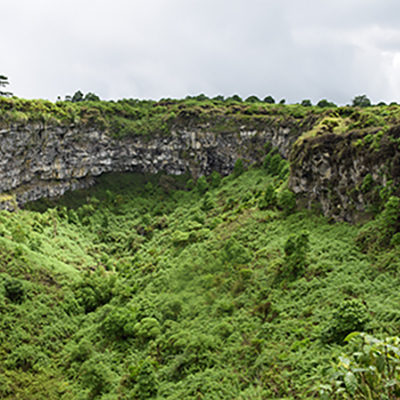
Wednesday: Santa Cruz Island:
AM: Charles Darwin Station: Here you will visit the research station where scientists from all over the globe work and conduct biological research from anatomy to zoology. See the breeding center, with new hatchlings and small tortoises not yet ready to be released into the wild.
PM: Los Gemelos: You'll also visit the highlands, where you can walk along a path, observing the hills, ferns, volcanoes, and rich wildlife. This area is home to giant tortoises, mockingbirds, Bahama ducklings, white-cheeked pintail ducklings, Darwin finches, and many other species. You will come upon the underground lava tubes, which are more than one kilometer (half a mile) long. Local guides are will provide information and flashlights. Walking through the lava tubes is a unique and surreal experience.
(Breakfast, Lunch, Dinner & Accommodations, Ocean Spray)
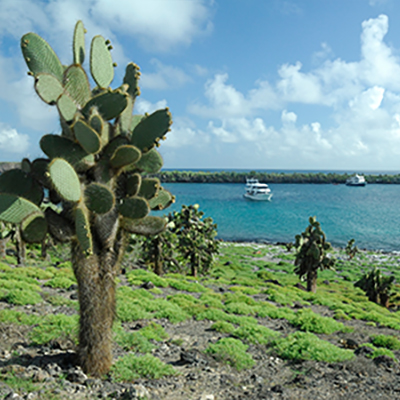
Thursday: South Plaza Island - Santa Fe Island:
AM: South Plaza Island: This small islet off the east coast of Santa Cruz has one of the largest populations of land iguanas in the Galapagos.
PM: Santa Fe Island: Santa Fe is a small island in the center of the Galapagos Archipelago. It is home to a unique species of land iguanas. From our landing site we can get a good view of the giant prickly pear forest. Groups of sea lions will be found along the beach.
(Breakfast, Lunch, Dinner & Accommodations, Ocean Spray)
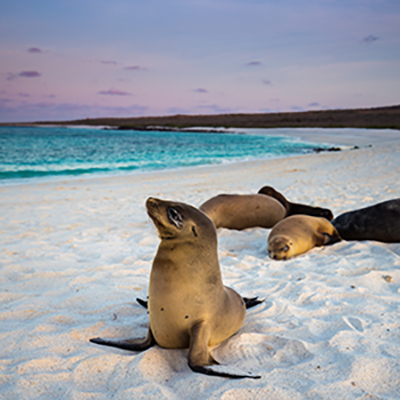
Friday: Española Island:
AM: Suárez Point: A dry landing at Suárez Point. This rocky land spot sustains one of the most impressive and varied colonies of sea birds in the Galapagos. High cliffs rise up from the sea, permitting spectacular views of soaring birds and an impressive blowhole.
PM: Gardner Bay: We sail to the northeast coast of Española to visit Gardner Bay, home to a large colony of sea lions. There is an excellent beach for relaxing or swimming. Then sail on to Osborn Islet, a small island where you can walk across a lovely white sand beach amongst a busy sea lion colony or dive into the water to swim with sea lion pups. This small island is a marine visit where you can enjoy fantastic snorkeling and swimming.
(Breakfast, Lunch, Dinner & Accommodations, Ocean Spray)
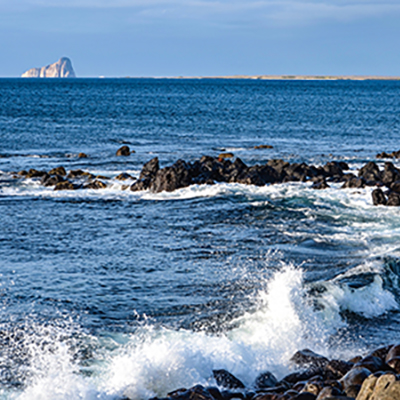
Saturday: San Cristóbal Island
AM: Interpretation Center: The Interpretation Center was opened in 1998 as a phase of the project "Interpretation and Environment Education Project." Visitors enjoy expositions on natural history, human history, and conservation. The conservation efforts represent the movement to protect the wildlife and natural environment through means of population and tourist control. Next, visit La Galapaguera, a visitor site in the southeast part of San Cristóbal Island that can be reached in roughly one hour by road from Puerto Baquerizo Moreno. On the trees and shrubs surrounding the site, you may see land birds like warblers, finches and mockingbirds, and on the trails, giant tortoises.
PM: Isla Lobos: This islet is a one-hour boat ride from San Cristóbal. It is a seasonal nesting location for blue-footed boobies, although it is named for the colony of sea lions sometimes present there. Fur seals and frigatebirds may also be present. The islet has a tranquil and scenic atmosphere and is also a great place for snorkeling. Visit Leon Dormido, a striking rock formation is located a couple hours off the western shore of San Cristóbal. Jutting out of the water, the rocks stand vertically at hundreds of feet above the ocean divided by a small channel. Although there are no landing areas, kayaking and scuba diving allow visitors to spot a variety of marine life.
(Breakfast, Lunch, Dinner & Accommodations, Ocean Spray)
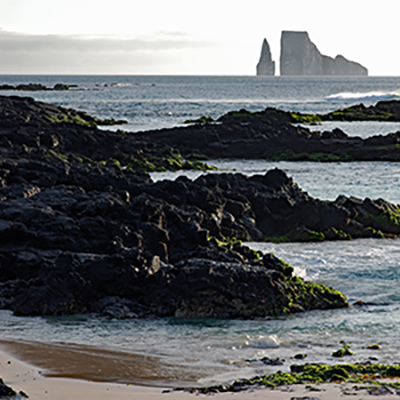
Sunday: San Cristóbal :
AM: Pitt Point At the far eastern end of San Cristóbal is Punta Pitt. Disembarking onto the small beach, visitors are confronted by the strong scent and cacophony of barking sea lions. A steep gully leads up the cliff to a breeding ground for boobies of all three varieties: red-footed, blue-footed and Nazca. It's the only place in the Galapagos where you can see all three species nesting together. Two species of frigate birds are also present, as are swallow-tailed gulls and storm petrels. The tops of the cliff overlooking the beach provide excellent views.
PM: Cerro Brujo This afternoon we land on the fifth-largest island, at a beautiful white-sand beach full of pelicans, blue-footed boobies, sea lions and marine iguanas. This beach is also a good place for swimming and snorkeling.
(Lunch, Dinner & Accommodations, Ocean Spray)
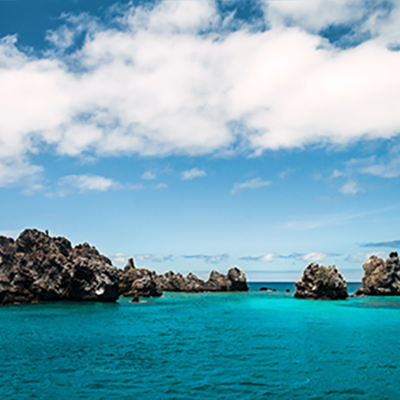
Monday: Floreana Island:
AM: Post Office Bay:
Here there is a white sand beach where in the past, sailors used to leave and receive their letters in a barrel. Then ascend an elevated slope to enjoy a beautiful vista at the Baroness' Observatory. Here you will have stunning views of the flamingo lagoon, coastline, and the interior of the island.
PM: Cormorant Point:
After a wet landing, take a trail overlooking a saltwater lagoon that offers views of a large flamingo colony. There are many other species of birds, including pintail ducks, common stilts and other migratory birds. See the two distinct beaches - the "Green Beach" and the "Flour Sand Beach." After this visit, we cruise to Devil's Crown. One of the best snorkeling sites in the Galapagos, this volcanic crater has been eroded by the waves leaving the northern and southern sides poking out of the water. The coral reef in the middle is perfect for attracting marine life. Snorkelers enjoy the variety of marine life and exciting currents that rush through the crown, creating an exhilarating experience.
(Breakfast, Lunch, Dinner & Accommodations, Ocean Spray)
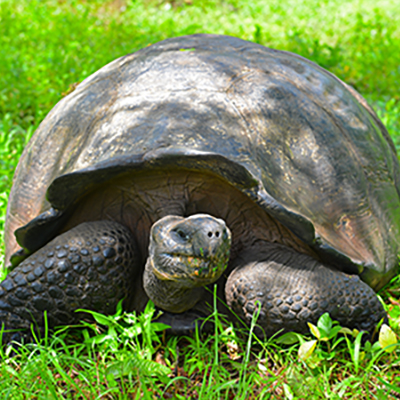
Tuesday: Santa Cruz Island - Bartolomé Island:
AM: Santa Cruz - Black Turtle Cove: Black Turtle Cove is situated in the northern part of Santa Cruz. This inlet is surrounded by mangroves and is only accessible by dinghy. The shallow cove is a safe haven for young marine life. Black tip and white tip reef sharks, sea turtles, and a variety of rays are often spotted here.
PM: Bartolomé - Pinnacle Rock: Bartolomé is a barren islet in Sullivan Bay to the east of Santiago Island, and is home to a distinctive and recognizable site of the archipelago: Pinnacle Rock. Pinnacle Rock, a volcanic cone, was formed when magma was expelled from an underwater volcano; the sea cooled the hot lava, which then exploded, only to come together and form this huge rock made up of many thin layers of basalt. Bartolomé is the most visited and most photographed island in Galapagos. Visitors have access to two sites: one that involves a climb to an incredible viewpoint and the other at the beach where snorkeling and swimming is enjoyed. Birdwatchers should be on the lookout for Galapagos penguins, herons, and Galapagos hawks.
(Breakfast, Lunch, Dinner & Accommodations, Ocean Spray)
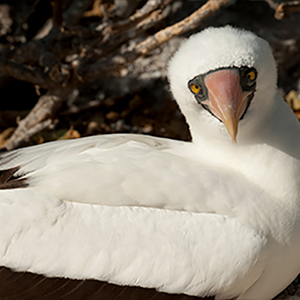
Wednesday: Genovesa Island:
AM: Darwin Bay: This white-sand coral beach heads a half mile trail that winds through mangroves filled with land birds. Nazca boobies, red-footed boobies, and swallow-tailed gulls can be spotted here. Further down the path are tidal pools where sea lions swim playfully. At the end is a spectacular view off a cliff.
PM: Prince Phillip's Steps: Also known as El Barranco, Prince Phillip's Steps' steep, rocky paths leads up to a high cliff-face. A marvelous view can be appreciated from here. This site is also home to Palo Santo vegetation as well as red-footed boobies, short-eared lava owls, Galapagos swallows, and Galapagos doves.
(Breakfast, Lunch, Dinner & Accommodations, Ocean Spray)
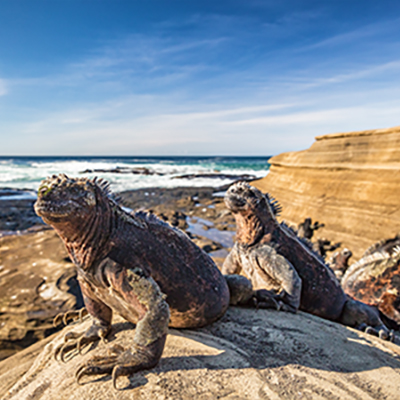
Thursday: Santiago Island:
AM: Espumilla Beach: Espumilla Beach is a popular place for marine iguanas and Sally Lightfoot Crabs. The crabs attract the hunting herons, performing the dance of predator and prey. With an abundance of marine life including octopi, moray eel, and shark, snorkeling is highly recommended. Next visit Buccaneer Cove, which was once a safe haven where pirates in the 1600 and 1700's would stake out on the Northwestern side of Santiago Island. Sea turtles now take the pirates place and dig their nests for their eggs near the Mangrove trees. It is a great location for snorkeling and many marine birds and sea lions can be found here.
PM: Puerto Egas: Also known as James Bay, Puerto Egas is home to the curious Galapagos hawks and quick-footed Galapagos lava lizards. The trail leads to a coastline with gorgeous tide pools and grottos full of fauna. Here the Galapagos fur sea lions bathe in the sun. This is also a great snorkeling site.
(Breakfast, Lunch, Dinner & Accommodations, Ocean Spray)
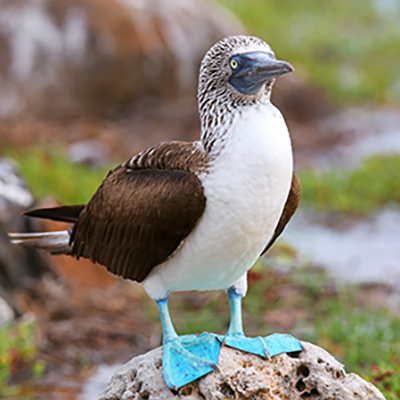
Friday: North Seymour Island - Santa Cruz Island:
AM: North Seymour Island: Galapagos sea lions, blue-footed boobies and magnificent frigatebirds are abundant on North Seymour Island. The island was formed by a series of submarine lavas containing layers of sediment that were uplifted by tectonic activity.
PM: Santa Cruz - Los Gemelos: You'll also visit the highlands, where you can walk along a path, observing the hills, ferns, volcanoes, and rich wildlife. This area is home to giant tortoises, mockingbirds, Bahama ducklings, white-cheeked pintail ducklings, Darwin finches, and many other species. You will come upon the underground lava tubes, which are more than one kilometer (half a mile) long. Local guides are will provide information and flashlights. Walking through the lava tubes is a unique and surreal experience.
(Breakfast, Lunch, Dinner & Accommodations, Ocean Spray)
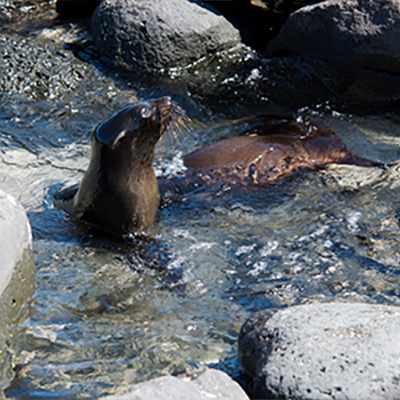
Saturday: Mosquera Island:
AM: Mosquera Island: Located between the islands of Baltra and North Seymour, this reef of rocks and coral (the result of an uprising) is only 160 meters across at its narrowest width. This island has one of the largest populations of sea lions and is home to many shorebirds. There have been occasional reports at this site of Orcas feeding on sea lions.
After this visit, we will head back to the airport for the return flight to the mainland.
(Breakfast, Ocean Spray)
** Itinerary and inclusions are subject to change

